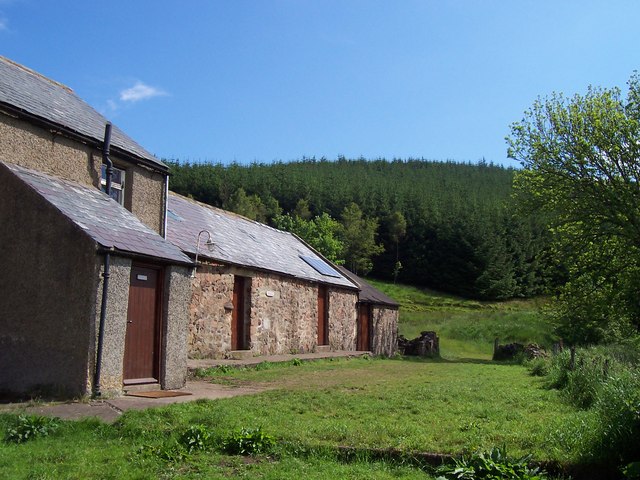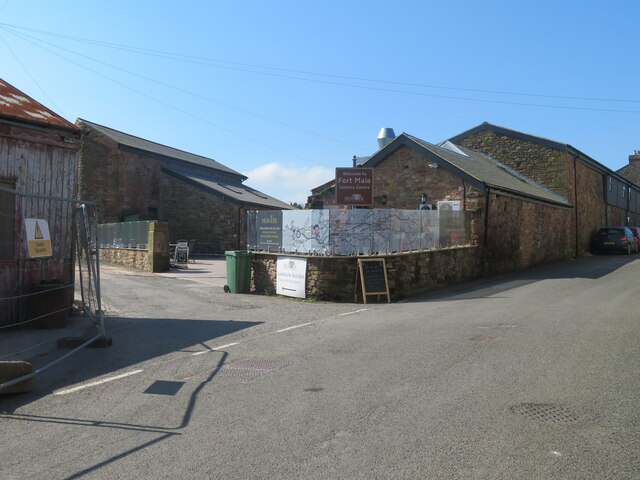Topics > Northumberland > Kidland > Kidland - Historical Account
Kidland - Historical Account
Selected extracts from: Upper Coquetdale, Northumberland: Its History, Traditions, Folklore and Scenery (David Dippie Dixon, 1903):
Kidland area and boundaries
Roughly speaking, the lordships of Kidland consists of about 17,000 acres. The heights of Cairn Hill (2,545), Score Head (1,750), Butt Roads (1,718), Cocklaw (1,700), and Windy Gyle (1,965) form its northern boundary; as the ridges of Wether Cairn (1,834), Sting Head (1.500), Cushat Law (2,020), Bloodybush Edge (2,001), and Lint-lands (1,665) form its eastern limits; while its western confines extend from Black Braes (1,654) along the crest of Hindside Knowe (1,501), as far as Rowhopeburnmouth, at Slyme-foot, thence down the Coquet to Barraburn. Its southern boundary, commencing at Wether Cairn, runs west by Allerhope burn and Kidlandlee dean; leaving the latter, it takes a northerly direction, keeping the tops of the hills on the left bank of Usway burn, until it reaches the summit of Yearnspath Law (1,775). North of Fairhaugh it crosses the Usway, mounts Middle Hill (1,296), and, striking Barra burn, follows its course by the foot of Kyloe Shin (1,418) down to the river Coquet.
Border Raiders
For upwards of three hundred and fifty years (1181 to 1536) the monks of Newminster held the lordship of Kidland. During the greater part of that period its pastures were let to the border men on the English side of the Cheviots, but at one time the brethren, finding tenants scarce, and rents small, were induced to farm it themselves ; therefore, stocking it with their own sheep and cattle, they sent their servants - probably lay brethren - to tend and guard the flocks against the raiding Scots and men of Redesdale. Notwithstanding these precautionary- measures, the wild border thieves "lifted" the cattle of the monks in such numbers, besides murdering their herdsmen, that they were fain to give it up, and once more let the Kidland grazing grounds to the hardy borderers of Upper Coquet who, living near the spot, were not only better able to hold their own, but when occasion served were not at all averse to replenish their stocks by reprisal raids upon their neighbours' herds, for - "Near to Border frontier in time of war. There ne'er a man Init he's a freebooter."
Shealings
Along the banks of the Kidland streams are found numerous foundations of buildings and enclosures, most of them rectangular, some of them roughly rounded, which have frequently been taken for British dwellings. These are, no doubt, the remains of the summer huts or "shealings" of the .shepherd monks of Xewminstcr. Traces of a much earlier occupation are, however, foinul .scattered over some of the hillsides. On the western slopes of Dryhope Hill, overlooking the Yoke burn, occur a number of small mounds containing the burials of a pre-historic race, and on the same hill are a series of earthworks and hut-circles. Further down the valley of the Alwin are circular camps - on Clennell hill, Gallowlaw, and Lord's Seat, close in to Alwinton ; but up the main valley of the Coquet, above Alwinton, the remains of those ancient dwellings are extremely scant. The late Dr. Hardy, who carefully explored the Coquet and its tributary streams far up amongst the hills, found very few traces of a pre-historic population, as the following extract from his report will shew : -"I have," says Dr. Hardy, " been alone or in company with Mr. James Thomson (Shawdon) over the greater part of Kidland, or the remote and desolate moorlands about the head of the Coquet, and all along the peaty, swampy, and broken ground from the Hanging Stone to Chew Green, and southward to the line of the Western Watling Street at the Outer Golden Pot and the head of Cottonshope, and across behind Thirlmoor and Philip and Blindburn, and questioned the shepherds wherever they were met, without eliciting much information on the subject of this enquiry.
There are two classes of hut-dwellings in the sheltered ravines of this undulating congeries of hills, or in the nooks of their many winding streamlets, not readily separable - the elder aborigines, the more modern of the shielings of the Borderers, who summered their cattle and sheep upon the mountain pastures. These are less numerous in the upper grains than in commodious positions lower down the courses of the streams. The remains of camps are scarce. Except the great sepulchral cairns crowning some of the hill-tops, as on Hogden, the Border ridge near the Windy Gyle, the three cairns of Thirlmoor, and a great green mound at the outcome of a feeder of the Coquet below Blindburn, and another on a hillock near that place, and situated to the west of it, the native tombs are rarely discernible. The suggestion so frequently repeated that Barrow (Barra) burn in Kidland, and the tributary of the same name that enters the Coquet above Alwinton derive their name from the numerous "barrows on their banks, is a mere etymological imagination. Barrow is not a North of England term as applied to sepulchral hillocks. In one of the early Charters of Newminster Abbey, the land adjacent to the Kidland streamlet is written "Alribarnes." Perhaps there were "barns" attached to the ancient mill here, whether it was a waulk4 or corn mill. Decayed alder trees are still washed up by floods near the exit of the Kidland Barrow (Barra) burn. I examined its course to the extreme uplands with a special outlook for barrows, and saw none. Of old the stream was called Hepden burn.
At the suppression of monasteries in 1536 the lordship of Kidland appears to have been reserved by the royal spoiliator himself, for in a survey of the borders made in 1541 Kidland is described as being the King's inheritance, lately belonging to the monks of Newminster. L}-ing upon an exposed frontier, open to the ravages of the numerous bands of mosstroopers and broken men more than any other district within theMiddle Marches, it is not surprising that the wilds of Kidland were considered, even by the hardy borderers, as an undesirable residence. ....
....Towards the latter part of the sexcnteenth century, better and more prosperous times appear to have dawned upon the borderland, due no doubt to tlhe happy union of the thistle and the rose; for we learn from the "Rentals and Rates for Northumberland," 1663, that '' Kecdnall I'pp or Kidland Extra Parochial"—a district of some 17,000 statute acres in extent, had a rental of £350, where at one time the tenants sat rent free, or at the nominal rent of 20s. in 1541 ; in 1631 it let for £5 in 1663 ;£350, in 1731 ;£400, in 1800 ;^3,ooo, while in the present day the rateable value is ;^2,384. The population in 1801 amounted to 60, in 181 1 to 54, in 1 82 1 to 62 persons, in 1891 to 79, and in 1901 to 77. The general aspect of Kidland has undergone little change since the days when it was in the possession of the monks of Newminster, except for the frequent wire fence that crosses one's path, or the blue slate roofs of the shepherds' houses perched upon the hill tops ; and the recently-erected mansion, the summer residence of Capt. Leyland, standing on the heights of Kidland-lee, 1,261 feet above sea-level, said to be the highest mansion in the land, with its carriage road winding up the steeps where never a road there was before. With these exceptions—the rounded summits of the hills, the deep narrow valleys, the rippling streamlets, the waving bracken are much the same ; while the cloud-shadows chase over hill and fell, the mists roll along the hollows, or cling to the mountain tops, exactly as when the Border pricker raided its hopes and harried its steadings, or when the gentlemen of Northumberland, with their sturdy retainers, rode along Clennell Street to the Warden's meeting at Windy Gyle on a truce day. The hills of Kidland are steep and massive, and of a considerable height, none of them being under 1,500 feet. The three highest are—Windy Gyle (1,963), Bloody-bush Edge (2,001) and Cushat Law — the Coiisthotelau of the Newminster Cartulary—(2,020). On the southern slope of this hill is a spot known as " Sting Cross," where, on a ridge between Cushat Law and Hogdon Law, stood one of the stone crosses mentioned by Hodgson, ^s which, he states, was on the track- way leading from Alwinton to Ingram in Breamish water. May this not have been one of the boundary crosses of the Newminster lands, as its site is on the boundary line or Kidland? Hodgson held that these crosses were erected as a guide to travellers in traversing these wild uplands.
Without the following amusing description of an olden type of Coquetdale sheep farmer, our account of Upper Coquetdale would scarcely be complete : —
" Illustrations of the character of ' Sir Burn,' of Kidland, Coquetdale. From Robert White's manuscripts : —Nearly one hundred years ago, James Burn, an extensive stock farmer, lived at Kidland Lee, in Coquetdale. It was customary with him indiscriminately to call both man and woman Sir ; hence among his neighbours he was usually named Sir Burn. He was kind-hearted, liberal to the poor, and fond to an extreme of hearing news. When none save his own family were likely to be present with him during the long winter evenings, he ordered one of his servant girls to go up to an eminence near the house, which commanded an extensive view, and endeavour to descry some poor people, for the purpose of giving them an invitation to lodge at Kidland Lee, and tell him all they heard of country affairs. In the winter season during a storm, instead of riding about and seeing his flocks duly attended, he was in the habit of lying in bed. Here he received the various shepherds as they entered the house—listened to every particular about their respective charges —gave them the necessary orders —and then laying hold of a large bottle of whisky, which he always kept within his reach, he bestowed it liberally upon them, telling them ' it wad keep oot the cauld,' and admonishing them to pay strict attention to the various hirsels under their care.
" In his preambulations over the country, and amongst his own people, he was, in the latter part of his life, accustomed to ride a white pony, and had a cur dog accompanying him, more remarkable for his noise than any other quality. When he had occasion to pass a flock of sheep, and ran some danger of scaring them by reason of the continued barking of the animal, instead of commanding it to be silent, he resorted to the more effectual method of pelting it with small stones, a full supply of which, to meet contingencies, he regularly stowed away in his pockets, before mounting on horseback.









